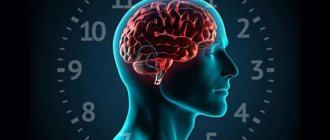Personality disorder or psychopathy is a disorder of a person’s mental activity, characterized by disharmony in the development of certain aspects of the personality. The first inconsistencies with generally accepted norms in behavior can be visible already at an early age. They become more noticeable during puberty, and over the years the symptoms become more pronounced.
Psychopathy is considered a kind of borderline state, bordering between health and disease. It is seen as a painful deviation from the norm, but is not a mental illness. Personality disorders have many types and forms, so treatment is selected individually, taking into account clinical characteristics.
Causes
According to statistics, about 12% of the population suffers from personality disorders. The reasons for their occurrence are ambiguous in most cases. The main predisposing factors to the development of mental disorders are of a genetic nature - the presence of mental illnesses, alcoholism, personality disorders in parents or close relatives.
In addition, the development of personality disorders can occur as a result of traumatic brain damage before the age of 3-4 years. Also, social factors can play a leading role in the emergence of this kind of pathology - inadequate upbringing of a child in the event of the loss of parents or in a family suffering from alcoholism. Violations arise against the background of inflicted psychological trauma - intimate abuse, manifestations of sadism, moral cruelty towards a child.
At first, the manifestations of the pathology have a clear picture, but with age, the symptoms have no specific boundaries and are reflected in all areas of life.
Symptoms
Personality disorder is characterized by alternating periods of social compensation and decompensation.
Compensation is manifested by the individual’s temporary adaptation to society. During this period, a person does not have problems communicating with people around him, and personal deviations are hardly noticeable. During decompensation, pathological personality traits become pronounced, which contributes to a significant disruption of the adaptive capabilities of social interaction.
This period can take either a short period of time or last for a long time.
Personality disorders during exacerbation may be accompanied by symptoms such as:
- distortion of perception of reality;
- a feeling of emptiness and meaninglessness of existence;
- hypertrophied reaction to external stimuli;
- inability to establish relationships with other people;
- asociality;
- depression;
- feeling of uselessness, increased anxiety, aggression.
The diagnosis of “Personality disorder” can be made only if there is a triad of Gannushkin-Kerbikov criteria for psychopathy, which includes the totality of personality disorders, the severity of the pathology, as well as the relative stability of the individual’s condition.
Schizoid personality disorder
Persons suffering from this type of pathology are characterized by excessive isolation, emotional detachment, and sociopathic tendencies. They do not need contact with people, prefer a solitary lifestyle, and most often choose work with the possibility of minimal communication.
When interacting with others, such people experience internal discomfort, a feeling of uncertainty, tension, and therefore avoid establishing trusting relationships and do not have close friends.
Patients with this diagnosis show interest in everything unusual, have non-standard views on things and well-developed logical thinking. They are also characterized by a passion for various philosophical problems, ideas for improving life, and exact sciences.
People suffering from this type of disorder often achieve excellence in mathematics or theoretical physics, have musical talent, and also the ability to establish unexpected patterns.
How to detect identity substitution in time?
During a person's transition from one state, a brief fainting may occur. This is an instant action that goes unnoticed by the people around him. Even the patient can ignore this and live quietly in a similar situation for several years. In this case, medical assistance is necessary!
Split personality has a direct connection with the brain. With the processes that take place in it. But they have not been studied. Doctors cannot give an exact definition and answer to the phenomenon. It can be diagnosed and treated for multiple personality disorder for years, but there is no guarantee that a person will be able to overcome the disease completely. We can only guess about the origin of this process. There is an assumption that otherworldly forces were involved here...
Paranoid disorder
Personality disorder of the paranoid type is characterized by increased distrust, pathological suspicion, and an exaggerated perception of injustice towards one’s own person. Patients with this diagnosis tend to see negative intent in everything, constantly feel a threat from the outside, and attribute negative intentions to others.
A paranoid person is characterized by increased confidence in his own importance, does not recognize that others are right, and is convinced of his own infallibility. Such a person is extremely sensitive to criticism addressed to him and interprets any actions and words of others in a negative way.
In a state of decompensation, the clinical picture is complemented by pathological jealousy, a craving for constant disputes and proceedings, and aggression.
What to do if a person refuses treatment?
You need to understand why he does this. It may take time to talk about the problem. Try to explain that there are no difficulties in the course of treatment and you will easily go through the path together. You shouldn’t tell scary stories, but you don’t need to lie that you’ll be cured in a month.
You can call a doctor yourself, without permission. You need to write a statement that will be the reason for the home inspection. If the doctor sees that the patient’s condition does not have symptoms that threaten his life and those around him, he is asked to sign papers for the course of treatment, but you have the right to refuse. Involuntary hospitalization is possible when a person is in a complex psychological disorder, and his actions can harm loved ones.
Dissocial disorder
Pathology is manifested by an indifferent attitude towards the feelings of others, irresponsible behavior, and disregard for social rules and responsibilities. Individuals with this diagnosis are characterized by behavioral non-compliance with social norms; they are characterized by open confrontation with the outside world and a criminal predisposition.
In childhood, the characteristic features of such individuals are increased conflict, lack of desire to learn, and opposition to any established rules. During puberty, persons suffering from this pathology show a tendency to theft, hooliganism, and frequent running away from home.
An adult with a dissocial disorder has no spiritual values, is unable to experience warm feelings, and blames everyone but himself. Such people assert themselves at the expense of the weak, do not feel pity, have sadistic tendencies, and are aggressive in bed.
Diagnostics
Antisocial disorder is diagnosed when at least 3 of the following are present:
- callousness and indifference to other people, inability to show empathy;
- regular and persistent irresponsibility, disregard for social norms and rules, responsibilities;
- inability to maintain long-term and close relationships, but at the same time good ability to make acquaintances and establish contacts;
- instability to frustration, low threshold of aggression and violence;
- inability to realize one’s guilt and learn from one’s mistakes, inability to draw conclusions from punishments;
- blaming other people, justifying one’s behavior (inventing good intentions), leading to conflicts;
- constant irritability.
Hysterical disorder
This kind of disorder occurs in 2-3% of the population, most often in females. This type of mental disorder is characterized by theatrical manifestation of emotions, frequent mood swings, shallow perception of phenomena, and inconsistency in attachments. Such people love increased attention to their person, so they try in every possible way to achieve this.
Patients with hysterical disorder are overly concerned with their appearance, strive for ostentatious external brilliance, and need constant confirmation of their irresistibility.
When building personal relationships, individuals with this diagnosis put their own interests first and try to achieve their goals at the expense of others through manipulation. They are painfully aware of the indifferent attitude of others.
Obsessive-compulsive disorder
This type of disorder is characterized by increased caution, a tendency to doubt, a desire to keep everything under control, and obsessive thinking. People suffering from this type of personality disorder strive for perfection in everything, which greatly interferes with the completion of the task itself. They are overly conscientious, scrupulous, too pedantic and demanding of themselves and others.
Such patients are convinced that only their lifestyle and concepts are correct, and therefore demand that others conform to their ideas. Often, these individuals develop obsessive thoughts and peculiar rituals, expressed in the constant need to count objects, repeatedly check whether household appliances are turned off, whether the entrance doors are closed.
The financial side of life plays a special role for such people. They are overly frugal in spending, which they also demand from others; money is perceived as something that needs to be put aside in case of a global catastrophe.
During the period of compensation, individuals with this diagnosis are distinguished by reliability, pedantry, and correctness in communication. During decompensation, they are bothered by a growing feeling of anxiety, due to which the patient becomes irritable, remains in a gloomy state, and has hypochondriacal tendencies.
Anxiety disorder
This type of pathology is accompanied by a constant feeling of anxiety, unpleasant premonitions, and low self-esteem. Such people try to avoid any contact with people, considering themselves socially inferior and personally unattractive. They are too shy, indecisive, and often lead a reclusive lifestyle.
Individuals with an anxiety disorder are pathologically afraid of criticism in their direction; they are hypersensitive to any negative assessments, and therefore try to avoid social and professional activities.
As a rule, people with this diagnosis adapt well to society, since in most cases the environment is sympathetic to the problem of such a person.
Narcissistic disorder
A clear manifestation of this kind of disorder occurs in adolescence. Patients experience an increased need for admiration from others, exaggerate their own importance in society, and do not accept critical judgments.
The main character traits of such individuals are complete conviction of their own greatness and the need to indulge all their whims. They are convinced of their superiority over other people, have an inflated opinion of their talents and achievements, and are absorbed in fantasies about their successes. They need increased attention and are focused exclusively on themselves.
Narcissistic individuals are clever exploiters and manipulators, thanks to which they achieve the fulfillment of their desires at the expense of others. Such people prefer a certain social circle that meets their high standards. They do not accept criticism and comparisons with “ordinary” people.
The inner world of these individuals is quite fragile and vulnerable, the emotional state is unstable and completely depends on external circumstances. Arrogance and arrogance are a protective mask that hides excessive sensitivity to rejection and criticism.
Dependent personality disorder
People suffering from this type of disorder are characterized by shifting responsibility for solving most life issues. The pathology is accompanied by a feeling of helplessness, pathological fear due to the inability to independently manage one’s own life.
As a rule, dependent people try to find a kind of patron with the help of whom they can at least somehow realize themselves in society. Such individuals need constant encouragement, advice, and approval of actions. Patients with this diagnosis are fearful, timid, unsure of their own abilities, unable to live without constant guidance.
The period of decompensation begins in the event of the loss of a patron, when life tasks must be performed independently, without prior agreement with him. The clinical picture during this period worsens significantly, which can lead to severe panic attacks without any particular reason.
Treatment
Treatment tactics depend on the causes of the pathology, the form and characteristics of the clinical picture. Only a psychiatrist can diagnose a personality disorder, and only a specialist should prescribe treatment measures. Self-prescribed therapy may not only not bring the desired results, but can also significantly aggravate the situation.
In a state of compensation, the patient does not need drug treatment. The basis of treatment measures in this case will be group or individual psychotherapy aimed at smoothing out pathological character traits. This method will allow the patient to learn how to respond correctly to certain life situations, which in turn will help him fully adapt to society.
During the period of decompensation, a person is considered disabled; if it lasts for a long period of time, there is a possibility of disability. Therefore, this condition requires immediate treatment. In this case, in addition to psychotherapeutic influences, drug therapy is prescribed to help relieve the symptomatic manifestations of the disorder.
To reduce anxiety, depression and other painful symptoms, selective serotonin reuptake inhibitors are usually prescribed. Anticonvulsants may be prescribed to control impulsivity and temper tantrums. To combat depersonalization and depression, drugs such as risperidone Risperdal are used.
The main goal of treatment is to eliminate the stressful state and isolate the patient from the external stimulus that caused the exacerbation of symptoms. This helps to reduce the severity of clinical manifestations - anxiety decreases, the feeling of hopelessness disappears, and depression is eliminated.
How to identify split personality yourself
Almost everyone can be dislocated when, for example, they show imagination, imagine themselves talking to someone or having their head in the clouds. Many kids invent imaginary friends, play with them and come up with various stories. This is not a paranormal phenomenon. The problem begins at the moment when a person cannot manage his personalities and switch in time. It can suddenly change from one to another. Scientists cannot say what caused this phenomenon.
During a person’s change from one personality to another, the following may be observed:
- A sharp change in character, changes in gestures, facial expressions, handwriting, voice, taste preferences. The person may begin to tell other stories from life. Often the opposite person has completely different habits and a difference in outlook on life.
- Ceases to control behavior, gestures, statements and actions. He can cry, be depressed, and after a few minutes burst into laughter to such an extent that it will be difficult to stop him.
- May manifest as incoherent speech, amnesia, or grunting.
- Memory lapses that eliminate memories, events that happened just the day before, and even habits. It is usually worth sounding the alarm when a person begins to forget too much information.
- One person may suddenly turn on and off. Therefore, even with a psychotherapist, he can tell completely different stories, simply because he does not remember what he said earlier.
- Poor health, insomnia. This could be a sudden tingling in the abdomen, problems with the digestive system, or a migraine.
But, even if most of the symptoms coincide, they are more often diagnosed with depression, anxiety disorder, and an apathetic attitude towards life. This only complicates the selection of methods.
Treatment takes a lot of resources and effort. Sometimes it can take a lifetime. But it is necessary to alleviate the patient’s condition and reduce the manifestation of symptoms. You can start treating the disease after appointing a qualified specialist. All information regarding treatment is given as a reference and is not a guide!
Personality disorder in children
In order to start treatment on time and prevent the pathological condition from worsening, you should be attentive to the psychological health of the child. As a rule, dependent and anxious personality disorders are the most common in childhood. Most often, the development of pathology is associated with a negative home or school environment, where moral as well as physical humiliation predominates.
The anxiety type of disorder is manifested by the following symptoms:
- low self-esteem;
- tendency to awkwardness;
- hypertrophied perception of problems;
- defensive behavior;
- reluctance to communicate with peers;
- increased anxiety.
If you have an addictive disorder, you may experience symptoms such as:
- victim behavior;
- excessive sensitivity to criticism;
- shifting responsibility to others;
- feeling of loneliness;
- reluctance to make decisions independently;
- lack of confidence in one's own strength;
- unstable emotional state.
If any symptoms appear, it is advisable to contact a qualified professional. Treatment for mental disorders in children is selected as carefully as possible. As a rule, therapeutic measures are based on the use of gentle drug therapy, long-term work with a psychologist, and constant monitoring by a psychiatrist.
Dissociative (conversion) disorder - symptoms and treatment
Dissociative disorders involve problems with memory, identity, emotions, perception, behavior and sense of self. Dissociative symptoms can potentially disrupt every area of mental functioning.
Examples of dissociative symptoms include the experience of alienation or feeling as if one is outside the body, and memory loss (amnesia). Dissociative disorders are often associated with previous experiences of trauma.
There are several types of dissociative disorders[2]:
- Dissociative amnesia (formerly psychogenic amnesia).
- Depersonalization/derealization.
- Dissociative identity disorder (formerly multiple personality disorder).
- Trance and obsession.
Dissociative amnesia and dissociative fugue
This form of the disorder is characterized by temporary loss of memory and memories due to a traumatic or stressful event. It is considered the most common dissociative disorder documented. The main symptom is difficulty remembering important information about yourself. Dissociative amnesia may relate to a specific event or to information about identity and life history. The onset of an amnesia episode is usually sudden and can last from a few minutes to several years (depending on the severity of the patient's injury).[4][5] The average age of people affected by this type of disorder has not been established. Therefore, a person may experience several episodes of this disorder throughout his life.
Dissociative fugue. Dissociative amnesia also includes dissociative fugue, which was previously identified as a separate type of dissociative disorders. It is a reversible amnesia for personal identity that pushes a person on an unplanned journey or wandering. Sometimes accompanied by the establishment of a new identity. This condition is usually associated with stressful life circumstances. May be short or long.[3]
Both dissociative amnesia and dissociative fugue usually appear in the adult population and occur less frequently after age 50. The International Classification of Diseases (ICD-10) classifies conversion disorder as a dissociative disorder,[6] while the Diagnostic and Statistical Manual of Mental Disorders (DSM-IV) classifies it as a somatoform disorder.
Depersonalization disorder
This form of the disease is characterized by periods of alienation from oneself or the surrounding world. This disorder involves persistent feelings of detachment from actions, feelings, thoughts and sensations, as if the person were watching a movie (depersonalization). Sometimes people may feel that other people and things in the world around them are not real (derealization). At the same time, the awareness remains that this is just a feeling and not reality. Symptoms may not last long or may return sporadically over many years. The average age of onset of this disorder is 16 years, although episodes of depersonalization may begin in early and middle childhood. Less than 20% of people with this disorder begin to experience episodes of such withdrawal after age 20.
Dissociative identity disorder
This disease is characterized by alternating multiple personalities. A person may feel that one or more voices are trying to take control of them. Often these individuals may have unique names, characteristics, mannerisms, and voices. In extreme cases, the host personality is unaware of the other alternating personalities; however, alternate identities may be aware of all existing identities.[3] People with dissociative identity disorder will experience gaps in their memory of daily events, personal information, and traumas. Dissociative identity disorder is caused by ongoing childhood trauma that occurs before the age of six.[7][8] People with dissociative identity disorder usually have close relatives who have experienced similar experiences.[9]
Women suspected of having a personality disorder are diagnosed more often than men because they are more likely to exhibit acute dissociative symptoms. Men tend to deny symptoms and history of trauma. This may lead to an increased likelihood of a false negative diagnosis.
Trance and obsession
Such conditions include disorders that arise against the background of a traumatic situation, in which the sense of personal identity is temporarily lost, consciousness narrows, and the perception of what is happening around changes. Sometimes a person feels that he is acting under the influence of another personality, "force", spirit or deity.
The patient's attention can be focused on certain movements, postures and statements. Their set is limited, and a person constantly repeats the same thing. In a state of trance, the patient can go on a long trip or walk, but upon regaining consciousness, he will not be able to understand how and why he ended up in this place.
The category "Trance and Obsession" includes only involuntary and unwanted trances that interfere with daily activities. Conditions that arise and persist within religious or other socially acceptable situations are not classified as dissociative disorder.
Also excluded from this group:
- trances in schizophrenia;
- acute psychosis with delusions and hallucinations;
- temporal lobe epilepsy;
- traumatic brain injury;
- intoxication with psychoactive substances.
General prevention
Unfortunately, there is no specific standard for the prevention of various personality disorders, since each person is individual. However, it is still possible to prevent the development of mental disorders in a child. For this purpose, many mental health programs have been developed today to help parents and children solve family problems.
These types of programs are mainly educational in nature - they involve lectures and discussions aimed at understanding developmental psychology.
Adults suffering from a personality disorder should not neglect the services of a psychiatrist. If you are unable to control your emotions and reactions, it is advisable to consult with a competent specialist who will prescribe appropriate therapy.
Despite the fact that this kind of personality disorder is not a mental illness, during the period of decompensation a person is not able to independently overcome painful symptoms. Therefore, to avoid undesirable consequences, you should definitely seek medical help.
General information
Currently, dissocial personality disorder is considered one of the most controversial categories that often arise in the clinical field.
Some argue that this is not a disease, but just a cover for criminal elements and scammers, while other experts claim that it is a real mental disorder. All psychopathic individuals suffering from dissocial personality disorder are united into a separate group due to underdeveloped high moral feelings. This type of personality disorder is distinguished into a special category using characteristic social criteria, including the inability to strictly follow the prevailing social norms in society, as well as to be law-abiding citizens . As a rule, sociopaths remain indifferent to various social standards; they are distinguished by their love of strong sensations, are often impulsive and generally lack a sense of responsibility . No matter how they are punished, no matter how many penalties are imposed, this category of people is unable to learn absolutely no lessons, even from their own negative experience.
If we approach dissocial personality disorder from a clinical position, this mental illness is allocated to a special group according to conditional characteristics. The domestic nosographic tradition does not currently distinguish this group of human personality disorders. Many researchers believe that a special category of psychopathic personalities simply cannot exist, since the tendency to break the law is in no way included in the symptoms of dissocial personality disorder.
This point of view has significant grounds, since legal violations are possible with absolutely any type of personality disorder, as well as with absolutely mentally healthy individuals. However, today an unpleasant and often inexplicable fact is becoming not only a clinical, but also a forensic psychiatric reality. Thus, quite often persons with a certain psychopathic disposition become repeat offenders, spending more of their time in prison than in the wild. Such citizens commit criminal acts many times, and psychiatrists classify them as individuals of the excitable type, although differences from them are often discovered. At the same time, some individuals are classified as suffering from schizoid personality disorder , while others are attributed to narcissistic syndrome or emotional instability .










